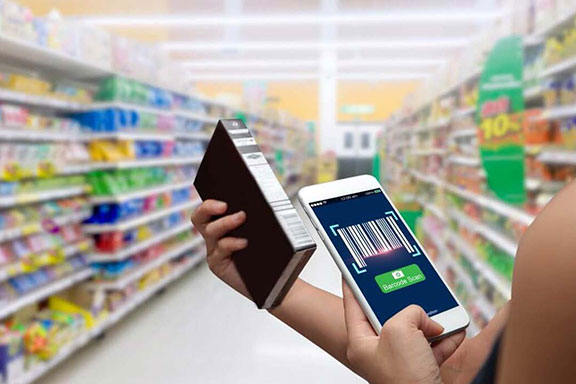Volume 23 | Issue 3
Click here to read the complete illustrated article as originally published or continue below to read the text article.
Fast-Moving Consumer Goods (FMCGs) is a frequently used term elsewhere in the world for what in the United States are commonly referred to as consumer packaged goods. FMCG is actually a more accurate description because they are exactly that—fast moving. They have short shelf lives, sell quickly in large quantities at relatively low cost, either because of high demand (e.g., soft drinks, confections, cosmetics) and/or because they are perishable (e.g., dairy products, baked goods, meat).
Historically, FMCGs are high market performers, building their business model on a on a well-established relationship with wholesalers and brick and mortar retailers. FMCG did product development, production and marketing and negotiated advantageous placement of their products in stores, which sold the products to consumers. That was before the increasing popularity of online shopping. Most significantly, the COVID-19 global pandemic has forced more consumers to rely on online shopping, particularly to order FMCGs they would previously have purchased at their grocery or drug store or super center.
“People have grown accustomed to ordering FMCGs online, something previous to the pandemic they might not have thought to do or thought they were able to,” notes Matthias Förster, VP and Global Consulting Industry Leader for Atos, an international IT company with a focus on helping clients achieve their digital transformation goals. “Customers have now realized that online retailers not only offer electronics or hardware or books or music, but also items for everyday use. And they like the experience. Once COVID is brought under control and we go back to something that was like normal life again, shoppers aren’t going to stop buying FMCGs online. That experience is now part of our new normal.”
Which creates new challenges for FMCGs, as well as new opportunities, that require new digital tools and strategies.“You might think, so what, then customers buy online instead of offline, why should FMCG care? But online sales are played by a different rule book. Traditional shops have a limited shelf space, so to become listed is always the first challenge for newcomers and a market entry barrier that protects established FMCG brands. They don’t have that advantage on an online platform. Also, you cannot negotiate a reserved space on the shelf at a particularly good spot in the store or a guaranteed sales volume.” notes Förster.
He likens the difference in shopping experiences to the difference between hunters and gatherers. “When you walk into a brick and mortar store, you might have had a plan to buy some milk and eggs, ‘hunting’ for just these. But the abundance of tempting products on display turns you into a ‘gatherer’. You wound up at the register with a basket full of frozen foods and items on special.”
The online experience in contrast is a hunting experience, optimized to quickly find items one is intentionally looking for. And here the consumer is guided completely differently.
Förster explains, “Someone types in a search engine for a household item. What search results will the platform present on top? Your brand that you’ve invested so much marketing dollars into and that used to have the best spot in the physical shop? Or the best seller, the cheapest one or even the retailer’s own brand product? FMCG companies lose the level of control they used to have.”
And he sees more risks that platforms pose to them. “Online retailers know it all: who sold to whom and at what price, where and when. They are able to create own, competitive brands and offer them at an optimal price to former buyers of this product item or simply always on top of search results and cross-selling suggestions. And they already do,” Förster adds.
So, FMCG needs to get their strategy right. Depending on product and brand they might chose to establish their own platforms or join forces with others, or select some retailers platforms and negotiate terms with. “They also have more experience with product launches, they have a highly optimized production and established supply chain, and they have a loyal customer base that put trusts in them based on their reputation for safe and healthy products and, increasingly, carbon-neutral and sustainable practices. They need to build on that.” Förster points out.
He adds, however, that, “The problem is that protecting brand identity is challenging online, where counterfeit goods proliferate, and shoppers are easily confused about what is real and what is not.”
There are a number of digital tools to identify potential copyright and brand infringements.
These include:
Another potential threat to established brands is the opportunity for new and less-established FMCGs to enter the market. “Even for experienced brands, the failure rate for a new product entry is 90 percent. The risk is still there. What’s difference is that the cost of that risk is considerably lower online than it is for physical stores,” Förster says. “It’s way easier to build a product portfolio online.”
There’s a range of digital tools available for FMCGs to advance their online footprint and win market share, even against well-established brands. These include:

According to Förster, “To stay competitive, FMCG companies must identify the next level of productivity gains and reduce cost base in production, supply-chain and back-office operations. The smart factory concept combines various digital tools and technologies to manage improve cost-efficiencies and product quality across the supply chain. A smart factory predicts with greater accuracy events such as market demand equipment failures, inbound delivery times, etc. and helps drive improvements in productivity, quality, inventory and operating costs.”
He adds, “There’s also much more flexibility to add, modify or eliminate elements of production and distribution. And in the digital world, it’s no longer necessary for an FCMG to own the factory or warehouse; it’s much easier to source, assemble and manage component pieces of the supply chain as needed.
One key element of the smart factory is the integration of data generated from the shop floor and other multiple enterprise systems that previously operated in isolation onto a mobile platform accessible to everyone in the business. “The right data, delivered to the right people at the right time to inform better decisions, enables collaboration and remote work and saves cost by simplifying processes,” Förster says.
Förster emphasizes that while FMCGs no longer have to compete for shelf space, there is no off-the-shelf solution to build a smart factory and deploy digital tools. “A smart factory is created by a unique set of investments in the most appropriate set of enabling technologies for a company’s specific situation, performance challenges and business objectives.”
“Technology does present pitfalls,” Förster cautions. “It’s easy to have unrealistic expectations, over-build solutions that waste time and resources instead of implementing simpler solutions that can deliver immediate results. There’s also the danger that if you fail to involve your people properly, or select a partner that doesn’t really offer a digital portfolio that’s right for your business model, you’re going to have significant issues rising to the challenges of digital transformation.”
FMCGs are redefining relationships and building opportunities online. New online sales and distribution models complement, in some cases replace, traditional retailer relationships. And there is the potential for FMCGs to come full circle.
“One thing I haven’t seen and would like to see achieved is an online recreation of the shelf buying experience,” Förster says. “Sure you can compare items online, but there’s nothing out there like a digital representation of shopping in a physical store, where you can actually look at multiple brands and see which one really catches your eye. That could be the next evolution in digital innovation.”
Whatever the future holds for both emerging and established brands, data-driven agility is key to achieve continuous and sustained competitive advantage. Knowing how to anticipate and exploit constantly changing opportunity demands entirely new digital skillsets and strategies. Such skills are not always inherent to an FMCG’s core competencies.
Which is why Förster emphasizes, “Atos partners with FCMGs to help ensure the design and execution of digital strategies are focused, adaptive and fine-tuned to achieve business objectives.”
For a more in-depth discussion of how FMCGs are grappling with the new retail reality, please refer to a recent Atos whitepaper authored by Förster, How FMCG Can Win in a Virtual World.

Dr. Matthias J Förster
About the Author
Dr. Matthias J Förster | Manufacturing Market, Global Consulting Industry Leader | Atos
Matthias has worked in various roles and executive positions for 30 years, first in the manufacturing industry, then in business/ IT consulting. He initiated and led complex digital transformations, especially for companies in the manufacturing, consumer goods and travel/ transportation industries. He did research on genetic algorithms for corporate planning and holds a degree in engineering and a PhD in economics.
About Atos
Atos is a leading international IT services company with a client base of international blue-chip companies across all industry sectors, focused on business technology that powers progress and helps organizations to create their firm of the future. A range of organizations depend on Atos as a trusted partner to provide the resources, scale and expertise to help clients achieve their digital transformation goals.
Scott Ellyson, CEO of East West Manufacturing, brings decades of global manufacturing and supply chain leadership to the conversation. In this episode, he shares practical insights on scaling operations, navigating complexity, and building resilient manufacturing networks in an increasingly connected world.